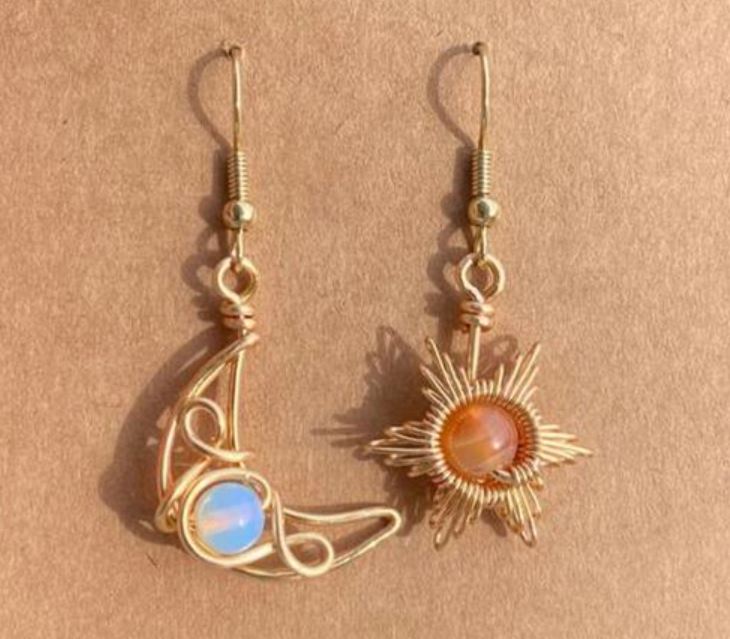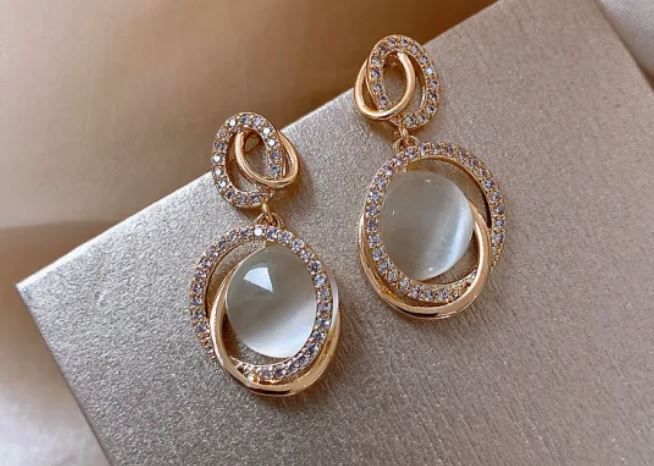Do Alloy Earrings Turn Your Ears Green
Yes, alloy earrings can turn ears green if copper is present in it. Commonly brass and bronze turn ears green. This is due to tarnishing which leaves green marks on ears and all over skin. Sensitive skin also plays an important part in this. Apart from green skin, they can also develop skin rash, irritation and allergies. That’s why it is necessary to know what alloys earrings you should not wear.
In this article we’ll answer do alloy earrings turn your ears green, what alloys do it and how can you save yourself from it.
Which Alloys Turn Skin Green?
Alloy earrings are made by combining two or more metals. It can be any two metals ranging from silver, copper, gold to platinum. Main reason behind making alloys is to enhance certain properties of the base metals, such as strength, durability, and resistance to corrosion.
Alloys that turn skin green are:
1. Brass
Brass is a combination of copper and zinc. It is commonly used in fashion or costume jewelry for its cheap price. It has a warm, golden color that resembles gold, making it a popular choice for affordable jewelry. As it contains a big percentage of copper, it reacts with sensitive skins to turn ears green.
2. Bronze
Bronze is another alloy of copper that can leave green color on skin. Just like brass, major part of bronze consists of copper. Similar to brass, it also turns skin green.
3. Nickel Silver
Nickel silver is made of nickel, copper and zinc. Nickel silver doesn’t contain any silver at all. Some people might get surprised to know it but it’s truth. It is also used in costume jewelry for its white and lustrous appearance.
4. Low Quality Gold
Low quality gold also contains high amount of copper. As karat of gold jewelry decreases from 24 k towards 10k, copper in gold content increases. This leads to more chances of having tarnishing. Higher pruity gold like 18k or 20k are the best which never tarnish.

Why Do Alloy Earrings Turn Ears Green?
Green coloration appearing on skin is due to a chemical reaction that leads to tarnishing. This reaction is in between the metal in the alloy and your skin. This reaction is particularly common with alloys that contain higher amounts of copper.
Copper, which is a primary component in many alloys such as brass, bronze etc. reacts with the moisture on your skin especially sweat and the air around it. This reaction produces copper salts, which are green in color. When these copper salts come into contact with your skin, they leave behind a greenish stain.
Though copper is the main culprit of leaving green stains in skin, other metals i.e. nickel can also contribute. Nickel, when mixed with other metals, can react with your skin natural oils and acids, leading to irritation and discoloration.
Factors Accelerating Tarnishing
Coming towards factors accelerating tarnishing. Several factors can accelerate the oxidation process, making the green discoloration more likely:
1. High Humidity
Moist environments provide more opportunities for moisture to interact with the metal, speeding up the oxidation process.
2. Acidic Skin pH
People with more acidic skin are more likely to experience oxidation, as the acids in sweat can accelerate the reaction.
3. Chemical Exposure
Exposure to certain chemicals, such as those in lotions, perfumes, and cleaning products, can also hasten the oxidation process.

Do all Alloy Earrings cause Green Ears?
Not all alloys will cause the same level of discoloration. Alloys with higher copper content are more prone to causing green stains, while alloys with metals like nickel or zinc may cause irritation or other types of discoloration. The specific reaction depends on the metals used and their interaction with your skin.
How to Prevent Your Ears from Turning Green
Fortunately, there are several strategies you can employ to prevent or minimize the risk of your ears turning green when wearing alloy earrings.
1. Choosing the Right Earrings
Choose earrings made from hypoallergenic metals like stainless steel, titanium, gold or platinum, which are less likely to react with your skin. It may cost you more but will come with a permanent remedy.
Some alloy earrings are coated with a protective layer of hypoallergenic metals like gold, rhodium, or another metal that can help prevent direct contact between the alloy and your skin, reducing the likelihood of green discoloration.
2. Preventative Measures
Applying a thin layer of clear nail polish to the parts of the earrings that come into contact with your skin can create a barrier between the metal and your skin, preventing oxidation. This can impact the overall look.
Anti-tarnish solutions can also be applied to earrings to protect them from oxidation and discoloration.
3. Proper Care and Cleaning
Clean your earrings regularly every month to remove sweat, oils, and other contaminants that can accelerate oxidation. Use a mild soap and water solution, and dry them thoroughly after cleaning.
Store your earrings in a cool, dry place, away from moisture and air exposure, to slow down the oxidation process.
What to Do if Your Ears Turn Green?
Green marks from alloy earrings is generally not harmful. These spots can be removed by simply washing the colored part of the body. However, there are other concerns to consider like allergic reactions when wearing alloy earrings.
As we know till now, alloy earrings can turn your ears green due to a chemical reaction. The foremost thing one can do here is to check for any allergic reactions and visit a dermatologist if there any. If there is no allergic reaction or problems like itching or redness of skin, washing with a soap or ethanol can solve the problem.
Alternatives to Alloy Earrings
If you’re concerned about green discoloration, consider alternatives to alloy earrings that are less likely to cause this issue.
1. Stainless Steel Earrings
Stainless steel is an excellent alternative to alloy earrings of copper or nickel. It is hypoallergenic, resistant to tarnish, and doesn’t react with the skin in the same way copper alloys do. Apart from this, it has a lustrous white appearance with affordable prices which can be suited to many. Stainless steel earrings are available in various designs and are known for their durability.

2. Sterling Silver Earrings
Sterling silver is another great option. It is composed of 92.5% pure silver and 7.5% other metals (usually copper). While it contains copper, sterling silver is less likely to cause green stains because of the higher silver content. Additionally, sterling silver can be easily polished to remove any tarnish that does occur. One can easily find these earrings from any jewelry store dealing in sterling silver.
Silver can also be found in other compositions such as argentium silver and 950 silver which can be even better options than sterling silver at a higher cost.
3. Gold and Platinum Earrings
For those willing to invest more in their jewelry, gold and platinum earrings are ideal choices. Pure gold (24k) is too soft for jewelry, so it is often alloyed with other metals, but high-karat gold (like 18k or 22k) and platinum are much less likely to cause any skin discoloration.
Gold is easily available in many compositions and appearances such as white gold, rose gold and yellow gold.
4. Rhodium Plated Earrings
If you’re not one of those willing to spend more money on gold or platinum based jewelries, rhodium plating might be the best choice for you. Rhodium is a bright lustrous metal known for its usage in jewelry plating over metals like gold, silver and brass. It is a hypoallergenic metal which never reacts with the skin.
The only con of rhodium plating is its wearing off where one have to do re-plating after every year costing around $50 to $60 depending on the price of rhodium.
Conclusion
Alloy earrings can turn ears green. Any alloy containing copper can turn skin green. Bronze, brass and low purity gold are among those alloys. Root cause of this coloration is either copper or the agents that speed up this reaction. There are some ways which you can adopt to get rid of this problem. High humidity, sweat, cosmetic items and sensitive skin are some of the factors that cause this coloration. In order to avoid, you have to follow the steps given in this article.

